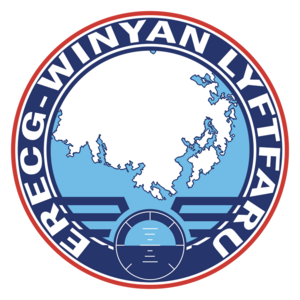Lower Vinyan Aviation
 | |
| Private | |
| Industry | Aerospace |
| Founded | 1922 in Fæstēah |
| Founder | Cadda Dagm |
| Headquarters | , |
Lower Vinyan Aviation (Fēþisc: Erecg-Wīnyan Lyftfaru), commonly known as EWL or Lower Vinyan, is a major Fyrish aerospace manufacturer and supplier of aircraft to both military and civilian sectors worldwide.
EWL played a significant role in the development of Fyrish missile and aircraft technology through the 20th century.
History
Founding years
Cadda Dagm founded Lower Vinyan Aviation on March 5, 1922, as a manufacturer of light aircraft. The aviation market snowballed in the years immediately after the Pan-Septentrion War, becoming a crucial industrial sector by the mid-1920s. Dagm sought to capitalise on this and hoped that light aircraft could enter the public eye as a tool of the future.
EWL's first aircraft, the Dagm-Pyttel, had two seats, a General Engine Co. 6-cylinder motor, and capacity for either a passenger or 130 lb (59 kg) cargo. The Pyttel debuted at the 1924 Escebo Agricultural Fayre but garnered little interest, to Dagm's disappointment. Although the Pyttle could cover more ground than traditional crop-sprayers, ineffective insecticides and fungicides existed to take advantage of the newfound speed of coverage. There was also insufficient knowledge of aerial topdressing at the time, which further hampered Dagm's aircraft sales.
Recouping from two unsuccessful Fayre debuts, Dagm sought to find an alternative customer for his aircraft in 1925. Upon approaching the Fyrish government, Dagm managed to accumulate some interest for potential trainer use, but the Pyttel lacked the characteristics for this role. Keen to further his ambitions, Dagm offered to modify the aircraft for the role. This modified aircraft, named Pyttel-2 unimaginatively, switched airfoil shape and added a more powerful General Engine Co. 9-cylinder radial. These changes made the Pyttel-2 a comparative racing horse compared with the mule-like Pyttel-1. Dagm presented the modified aircraft to the Chiefs of the Federal Airforce on April 10, 1926. The Chiefs were sufficiently impressed by the Pyttel-2's simplicity, agricultural ruggedness, and handling characteristics to place an immediate order for 100.
Raeloc
Following in his father's footsteps, Penda Dagm, also known as Dagm Jr., took an interest in aviation from an early age. Dagm Jr. worked for his father at EWL from 1927, as an assembly line worker. This position would not last for long, however, as Dagm Jr. worked his way up to systems engineer, and became a test pilot in 1935. Dagm Jr.'s aviation interests rapidly flourished during his time at EWL, and he grew particularly fond of rocketry-assisted take-off during this period. Under his father, Dagm Jr. experimented with catapult-launched and rocket-launched manned gliders and light aircraft through the 1930s. This passionate experimentation, and interested military parties, eventually convinced his father to support the creation of Raeloc under EWL.